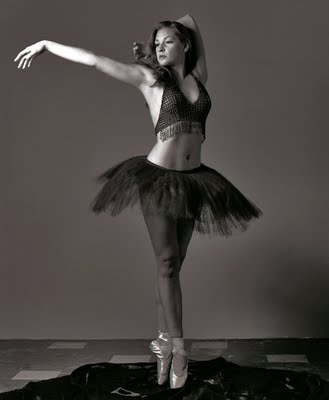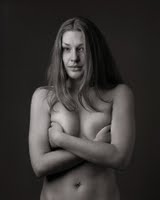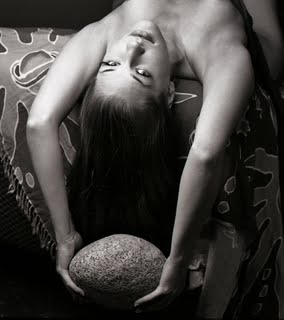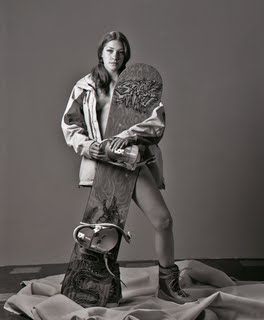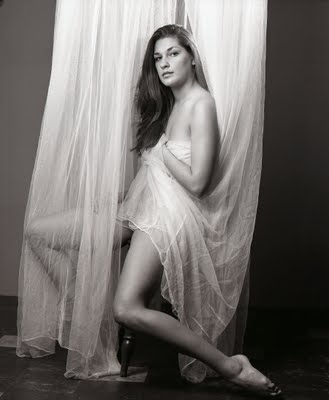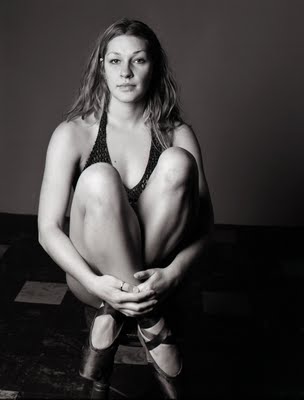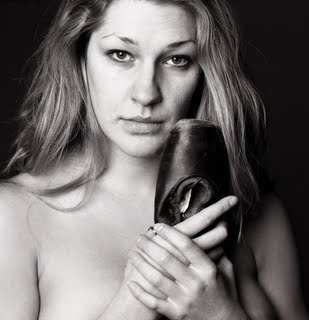That Shoebox Guitar
Monday, October 19, 2009
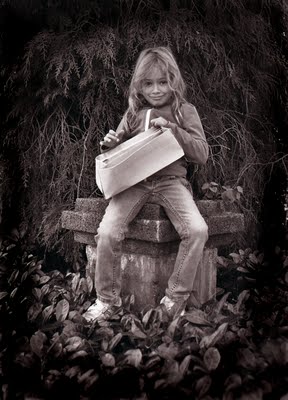
At 12 Rebecca has reached that threshold of adolescence which is marked by some confusion. I think it has come much earlier that it ever did for me.
In the 9th grade I was at St Edward’s High School, a Catholic boarding institution in Austin, Texas. I was barely 15. I remember making a scrap wood and tree branch shelter out in the bush with my friend John Straney. We would sit down and play the game of memorizing the correct names for all the WWII German fighter planes, bombers, tanks and battles. It was our secret hiding place. By the second semester John was no longer interested. I could not play the game alone.
Before I had moved from Buenos Aires to Mexico City in 1952 (I was 10) I had been playing toy soldiers with my Filipino cousin Robby. We had American GIs. My favourite had a bazooka on his shoulder. The nasty German and Japanese soldiers we blew up with our imagination. We dug little foxholes in my mother’s garden for our own version of the Battle of the Bulge. We flooded my mother's flower beds with a hose for the Battle of Leyte Gulf and fought each other as to which of us would say, "I shall return." In 1953 Robby and his family moved to Mexico. We followed a year later. When we arrived at the Mexico City airport I was shocked to see that Robby was taller and he had something on his face that I had never seen before. They were pimples. He did not want to play toy soldiers with me.
I would think that Rebecca will soon abandon the on-line computer game of dressing up celebrities. One day soon she will tire of Nancy Drew. I should not speed this up as soon she will not want to spend Saturdays with her boring grandparents. After all there will be all those boys to conquer.
That is why it is a pleasure to watch Lauren (7) play mostly by herself when she is not being read by Rebecca or Rosemary. I love to watch her slide in her socks on our wooden living room floor. At home she plays for hours with her large dollhouse. This past Saturday I delighted in watching her play her shoebox and rubber band guitar. The power of the imagination of a child must be kept for as long as possible. I will be most careful not to tell either Rebecca or Lauren to grow up.
Oskar ( The Tin Drum) would approve.
A Brevarium In Codex
Sunday, October 18, 2009
A Brevarium In Codex Seven times a day I praise you.
Ps. 119:164
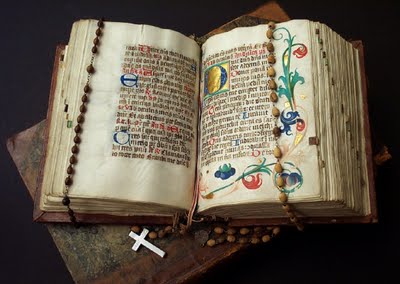
Breviarium for the use of Dominican Nuns
Germany : s.n., ca. 1430
LAT 096 B84g
This breviarium was penned in upright Gothic (lettres batardes) with eighteen lines to the page in black, red and blue; including numerous large initials on the finest vellum. Inside, a twelve page calendar is preceded by a circular sun and moon with double circles in gold, silver, red, blue and green. The first page and page 167 are decorated in gold and other colours, with decorative borders and wide margins. The breviarium comprises 536 pages and has its original cover made of brown calf skin over oak boards. The locking clasps on the cover are missing; it is also surrounded by borders that were blind tooled with the words Ave Maria Gratia plena. This is considered to be a very beautiful German MS. in perfect condition, circa 1430.
The breviarium was purchased for the Vancouver Public Library in the 1930s from a retired janitor in Kamloops; it may have been brought to Canada from Germany by a pioneering family.
Photo Above from Vancouver Public Library Special Collections Web Site
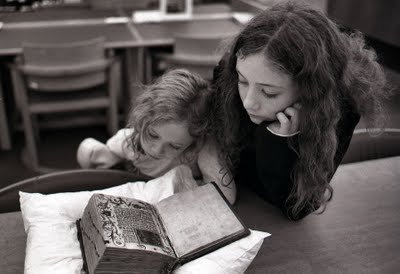
I had forgotten that palpable excitement that would rush through me when in my youth I would enter a good library. For close to 65 years I have frequented bookstores and spent lots of money buying books. There is little space left for them in our house. The public library has become a practical option. I had forgotten the wonder of randomly finding something that would suddenly interest me. I had forgotten that library staple, a stack called “New Books” and the pleasure of picking up each book and reading the book jacket.
On Saturday, after lunch I took Rebecca and Lauren to the main branch of our public library. I had done my homework the day before. I told the girls, “I have a surprise for you on the 7th floor. We could take the elevator but I would rather prolong the mystery by insisting we take the escalators." By the time we got to the 7th floor and on side Rebecca read the sign that said “Special Collections” she asked me what it was we were going to see. “Wait a few minutes and you will see,” I answered.
There were two female librarians. One of them looked extremely serious while the other one did not look like she had ever cracked a smile since books adopted the codex style. I decided she was the better bet and showed her an item that was underlined in a sheet of paper I had brought with me: Breviarium for the use of Dominican nuns.... 096 B846.
Both women disappeared for a while and they returned with a wheeled cart on which lay a smallish black box and a pillow. The more amenable of the two then put on a pair of cotton gloves and gestured to a nearby table. She placed the pillow on the table, opened the box and removed one of the nicest books I have ever seen that close. We all marveled at the sight and I asked the woman if she herself had ever seen it. She told us that she had been asked to show it a couple of times in the past. And she smiled!
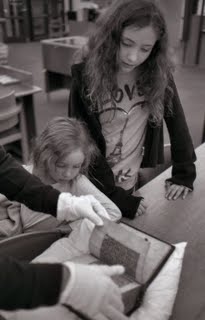
We went down the escalators and spent a pleasant afternoon looking at books in the children’s room which is most spacious. As we left for home with our booty (I had found a pop-up book on mummies that Lauren wanted to borrow and Rebecca, this time eschewing teen magazines took out three novels.) I experienced the realization that I had forgotten how exciting it is to visit libraries.
As soon as we got home I told Rebecca we were going to watch a film. She protested and told me she wanted to read. I was not going to argue with that! She lay down on our living room’s psychiatric couch to read her novel.
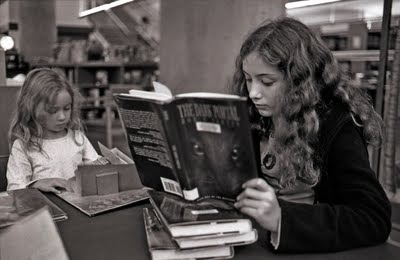
After dinner we watched from the series (The Artists’ Specials) the film Monet – Shadows & Light. It was beautifully done. As soon as it was over I brought into the den a nice big picture book from my collection called Impressionist Women by Edward Lucie-Smith. Rebecca, Lauren and Hilary looked at the pictures. Some were almost like still images from the film we had seen. Rebecca pronounced the name of the painters in her oh-so-nice French, Berthe Morisot, Eva Gonzales, Mary Cassat, Camille Pissarro, Edouard Manet, Auguste Renoir, Edgar Degas, etc. I felt content as I took the girls home.
Lauren had her own prize, too. Before the film we had seen the short film Madeline’s Rescue based upon the book by Ludwig Bemelmans and splendidly narrated by Christopher Plummer.
Of course the two films I checked out from the Vancouver Public Library.
Special Collectionshttp://vpl.bibliocommons.com/search?q=special%20collections&t=keyword
Bif & Nina's Dainty Footwear
Saturday, October 17, 2009
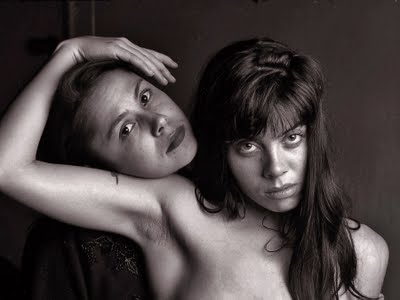 My perception of how shoes affect how I judge people was fundamentally changed some 12 years ago when two of my friends, Bif and Nina walked around in Dr. Martens and clunky boots. I told them that their shoe wear took away from their femininity. Bif with her tattoos and generous voice laughed at me while Nina, after a while, was bothered by my constant criticism. The two women must have had a discussion about it because they told me to wait for them in my studio. They assured me that my opinion on their clunky footwear would change. And it did. 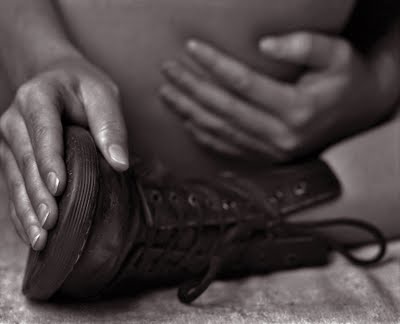 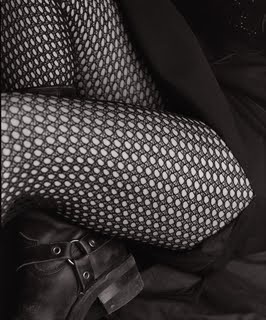 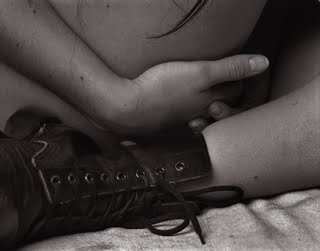 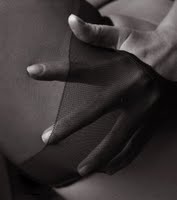
Emily Carr's Melancholy Ron Burnett
Friday, October 16, 2009
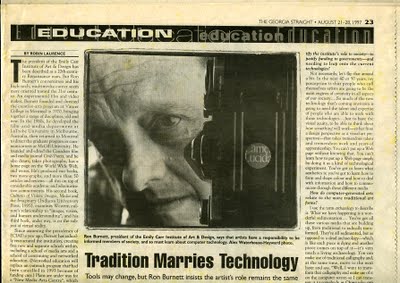 It may have been some 10 years ago that at a photographic group show at the Exposure Gallery (it was then on Beatty Street) I was chatting with a pleasant and young female photographer who had a picture on the wall next to mine. It was a show in which we were invited to use basic and or primitive box cameras. I think it was called The Low Tech Show. The pleasant female photographer, who was a recent graduate of the then Emily Carr Institute of Art & design, (it now has the far loftier name Emily Carr University of Art + Design with the corresponding accreditation and that mysterious replacement of & for a +) told me, “I really admire you Alex. I could never be a commercial photographer. I could never photograph sewing machines.” Some 15 years before an apologetic Vancouver Magazine art director, Rick Staehling had called me and assigned me to do just that. I took the job because honest money from any quarters is honest money. This young woman somehow knew about my sewing machine job. I looked at her and kept my temper knowing that had she not been a woman I would have punched him on the nose! 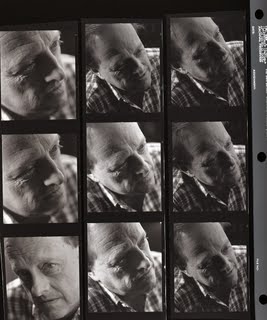 My relationship with the institution that is Emily Carr has been a varied one. For about 13 years I was an artist/techer in the Outreach Program of Emily Carr Institute of Art & Design that was pioneered by wonder woman Nini Baird. We artist/teachers (as we were called) went to teach photography, printmaking, painting, etc to remote communities of the interior. They were usually on weekends. The program was partially funded by the Province. It was Baird’s contention that the folks in the interior paid some sort of culture tax yet got nothing for it. Baird left Emily Carr for the Knowledge Network and the program at the institute soon died. I was later called with some regularity to teach something called Photographics to fourth year design students. I was never asked to show any kind of qulifications. I was hired on the merits of being a photographer who worked in that real outside world, that commercial world. Others were hired like designer Ray Mah and photographer James O’Mara. 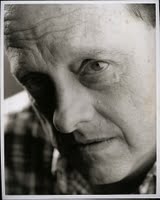 I was particularly proud that one year I had my students design a record album, the inside sleeve and the centre of the record. I told my class that I was going to bring a real, live rock star. I brought Art Bergmann. I told the class that Bergmann had to approve of their individual designs and that he was going to be difficult about this. My students rose to the challenge. I remember putting in a expense for a bottle of Chivas Regal. “What’s this?” the institute accountant asked me. “You don’t expect me to bring in someone to pose for my class without paying them, do you?” I told her. They paid.After those Photographics classes I was never called again. In early August 1997 the Straight assigned me to photograph the new president of the institute, Ron Burnett. When I went to his office he confessed a love for photography and that hatched an idea in my head. I had forgotten about this until I found Burnett’s files today and noticed the Straight tear sheet. I wondered how I had taken this photograph. The contents of the file soon refreshed my memory. I took 10 pictures of him with b+w negative film. I processed the film and chose on of the frames to print. I printed it and put a stiff cardboard backing. I wondered why I had done that. It seems I placed the print/cardboard combination on a stand outside and then put an old Pentax S-3 on its side on a tripod. I had the shutter locked on B and must of somehow placed Roland Barthes’ Camera Lucida in front. I am not sure if the camera had a lens or not. With cloudy day light I photographed the setup with my medium format Mamiya RB-67. 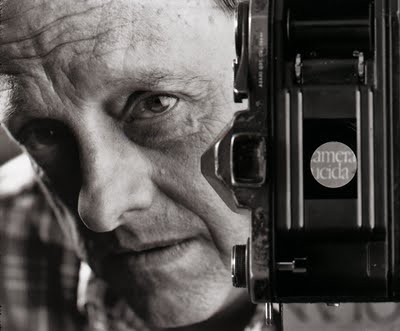 I never saw Ron Burnett again. I looked at his sad face today and wondered why he had stared at me like that. Burnett has been at the institute, now turned university, for 14 years. I wonder if he is more cheerful now. I wonder if the art students that are graduating from his university are now reluctantly willing to “sell their souls” to commercial endeavours while pursuing their art. Or are they like that young woman in my past who was so proud of her art that she might have opted for being a restaurant server than to photograph sewing machines?
Bloom's Spoons
Thursday, October 15, 2009
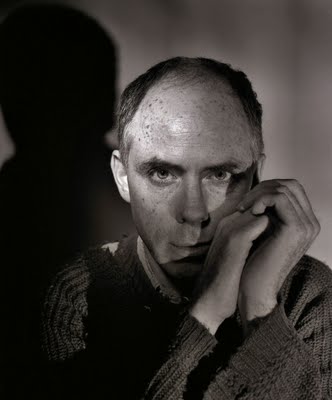 Theatre is much like film. Casts and the crew who work with them have a pecking order. There are positions in film like the grips. I have no real idea of what they do. Do they hold things? Many in theatre, like in film, are essential, some are also unsung. One of them is the Fight Director. In films like The Matrix we would all understand that the Fight Director or fight sequence director would be most important. A broadsword fight in a Bard of the Beach production of Macbeth would also be on that same league. 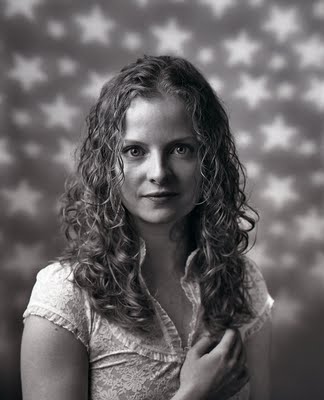 Then you go with your daughter, as I did tonight, to the opening performance of American playwright William Gibson’s, The Miracle Worker presented by the Vancouver Playhouse Theatre Company. You would never consider that a fight director would have any kind of relevance in a play based on the early life of Helen Keller. Fight scenes here? Impossible! Yet there are fights in this extremely fine production directed by Meg Roe (I remember her well from her killer role as an actress playing an autistic youth in the recent Vancouver Playhouse production of Toronto, Mississippi) which use scissor, spoons and other thrown objects that are so central to this play that without them The Miracle Worker would fizzle. It is a fight between a headstrong little girl who is unable to connect between the signs for letters, and the real objects, things and people they define, and a just-as-headstrong woman of 20 (not a teenager!) with a past that might just prevent her from finding a solution to the process of thought through language. 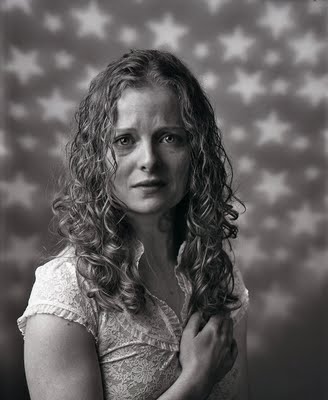 The unsung hero of that virtuoso spoon fight is Fight Director David Bloom seen here in picture above left. During the scuffle for the fallen spoon the theatre was so quiet that all I could hear was that spoon drop. Two little girls play Helen Keller, Margot Berner and Emma Grabinsky. If I understand well my program notes my daughter Hilary and I saw Margot Berner tonight. She was superb in her battle of wits with her nurse and teacher Annie Sullivan played by Anna Cummer. I must diverge here to give my account of my extraordinary experience in having Cummer in my studio back in 2005. I happened to ask her if she could cry on demand. I had been lucky before in that I had photographed two acresses who could do just that. Cummer looked at me and left the studio. A few minutes later she returned and stood in front of my camera with a face that was ravaged by sorrow. Little tears began to pour down her eyes. In this production of The Miracle Worker all the other actors, Hamza Adam as Percy/Doctor, Tom Butler as Captain Keller, Jennifer Clement as Kate Keller, Marci T. House as Viney and Bridget O’Sullivan as Aunt Ev were good given that it was just about impossible to compete with Cummer and Berner's strong performances in roles designed to be just that. 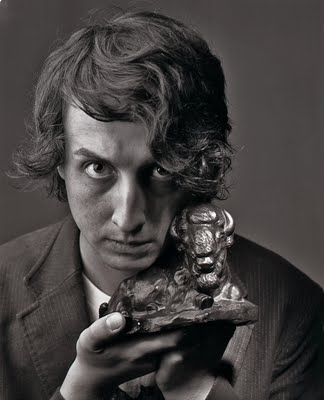 For me there was one other actor who stood out. He is one of my favourites in town. Ryan Beil played James Keller, a young man who does not seem to know how to please his father. Beil has a kind of Stan Laurel universal face that can adapt to any situation. I thought he was excellent in the Main Street Production of Glengarry Glen Ross. I ache to see Beil in a comedy that goes beyond the role limitations of this summer’s Bard on the Beach production of The Comedy of Errors. Beil can be funny and especially so if let loose! As Hilary and I watched the battle of wits between little Helen Keller and Annie Sullivan I kept whispering in her ear, “Lauren and Rebecca (my granddaughters and Hilary’s daughters) are easy in comparison to this!” It was around 11pm that Hilary called to say, “Lauren was impossible. She threw pens and pencils with such force against the kitchen stove, that she broke them. She refused to write down anything for her dictée. Her father has grounded her, including no TV until Monday.” I wonder if David Bloom might have approved. In the play Annie Sullivan says, "Obedience without understanding is a blindness, too." What would Sullivan have opined on grounding?
|























